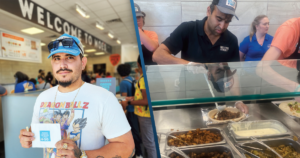 Paul and Marie Miller moved from Tampa to Wesley Chapel two years ago to get away from city living and to enjoy the country life. They bought 10 acres just north of S.R. 54, and figured they would spend their free time on their quiet, rural property.
Paul and Marie Miller moved from Tampa to Wesley Chapel two years ago to get away from city living and to enjoy the country life. They bought 10 acres just north of S.R. 54, and figured they would spend their free time on their quiet, rural property.
However, the city may not be such an easy place to escape.
A Connected City, which began planning in late 2014, is coming to a 7,800-acre area running north from Overpass Rd. in Wesley Chapel to S.R. 52 in San Antonio, and west from I-75 to Curley Rd. The Connected City is touted by developers and planners as a first-of-its-kind high-tech community with emphasis on gigabit internet access, job creation, alternative transportation along integrated roadways with two first-in-the-country man-made crystal lagoons all bolstered by a detailed 50-year plan.
Metro Development Group, a Tampa-based company, is leading the planning for the area. It owns about 30 percent of the property in the area, but will welcome the participation of other developers , doing everything from residential to commercial and retail.
Metro is already building one housing development at Epperson Ranch, and will begin construction on another starting next year. It also intends to build developments for office, retail, multifamily and light high-tech manufacturing.
Heidt Design LLC, which was also involved in the adjoining 22,000-acre Villages of Pasadena Hills in Zephyrhills – Pasco County’s largest development — was hired by Metro “to augment Pasco County’s resources to do this very special plan,’’ said Pat Gassaway, Heidt’s president.
 The Miller’s property, however, may be in the way of progress.
The Miller’s property, however, may be in the way of progress.
For the past two months, a series of community meetings have been held at Wesley Chapel Elementary (WCE) to address concerns of residents in the 7,800-acre area, some of whom will be displaced.
A fifth and final community meeting will be held on Wednesday, January 13, 6 p.m., also at WCE — to discuss the connected city corridor, a pilot program which was created by a Growth Management bill (SB 1216) which speeds up the process for creating city-connected corridors. For the 10-year length of the pilot program, there will be no state oversight.
Roads were the hot topic of conversation at the last community meeting. Construction on Overpass Rd. and Curley Rd., where four of the eventual six lanes of both roads are being built, is already under way. The project’s network of roads, approximately 144 lanes miles with 82 additional miles for alternative transportation, were presented to the 50 or so people in attendance at the last meeting on Dec. 2 on large poster boards with residents encouraged to make suggestions.
The Millers took a black magic marker and redrew the one road that concerns them the most — the one planned to run right through their property in the southeast corner of the Connected City area.
“I think the idea of a Connected City is awesome, but as it is right now, the road going through our property isn’t going to let us enjoy our property, our little oasis,’’ said Marie Miller. “I’d prefer this be done on a blank slate of land, not disrupting (existing) landowners.”
Many in attendance at a contentious Dec. 2 meeting say they also will be disrupted, either by the proposed roadways or the construction that will be required to build them. Bigger roads will equal fewer homes and less of their property, they said, especially along Tyndall Rd., the topic of most of the discussion at the last two meetings.
 “What’s in this for us?,’’ asked someone in the audience. Others said that the only ones benefiting would be the developers who were making money on the Connected City.
“What’s in this for us?,’’ asked someone in the audience. Others said that the only ones benefiting would be the developers who were making money on the Connected City.
Gassaway, while acknowledging that some residents will be displaced, replied that the roadways and infrastructure, “will benefit everyone in the area.”
At a Pasco Board of County Commissioners (BCC) Workshop at the Historic Courthouse in Dade City a few days later (on Dec. 8), Gassaway told county commissioners that there would be pushback on some of the items, including resistance from some residents on giving up their land and way of life. “But I’ve also had people come to me and say ‘This is a great idea, I can’t wait for you to buy my land,’’’ he added.
The Millers have hope changes can be made so roads bypass their land, but have resigned themselves to the possibility of having to sell.
“We have zero control,’’ Paul Miller said. “We realize they are coming and are going to do what they want to do, we’re just trying to gather the info so we can get the most value for what we feel the value of the property is.”
Gassaway noted that local residents can still have some effect on the roadway plans.
He noted that the most constructive and feasible recommendations from the Dec. 2 meeting could be implemented in the future. While six-lane roads are going to be mostly straight and therefore, “the amount of wiggling you can do to meander around constraints is somewhat limited,’’ Gassaway added that planners can be much more flexible when making changes along a smaller, winding path like Tyndall Rd.
“Well, we’re not aiming for them,’’ Gassaway said of the homes in the development area, but he won’t be able to pinpoint the exact number of the approximately 250 possible homeowners who might be affected until the latest community recommendations are studied.
The Allure Of Speedy Internet
Internet companies are always touting faster speeds to lure new customers. But what if you could upload an hour of high-definition video to YouTube in five seconds, or back up a 500Gb hard drive in less than 10 minutes, or load your entire photo collection to the cloud in half that time?
Those possibilities, and more, are coming to Wesley Chapel.
Last week it was announced that because of the connected city plans, Wesley Chapel will be home to the first planned “Smart Gigabit Community” in the United States to be built from the ground up, with a fiber network offering blazing internet speeds and serving as the backbone for new advances in education, healthcare, public safety and energy and transportation.
The “Smart Gigabit Community” will be the heart of the connected city corridor.
“It will ignite the next generation of American innovation,’’ Kartik Goyani, Metro’s vice president of operations, told commissioners on Dec. 8.
Wesley Chapel is already home to blazing fast ULTRAFi in the Union Park development, and cities like Kansas City and Cleveland and Austin, TX., neighborhoods are home to gigabit speed internet.
But US Ignite, a non-profit organization established in cooperation with the National Science Foundation and the White House Office of Science and Technology Policy, will work with Metro Development Group to make the connected city the first to install the network at the beginning of community development.
The allure of gigabit internet, however, has taken a backseat with the older crowds at the community meetings. Instead, residents want to how development will impact the Floridan aquifer, how sewers and sinkholes will be dealt with, and how the area, which has been beset with flooding the past few years, will handle any more water.
Previous meetings have addressed other issues that also have raised the ire of locals. The Nov. 4 meeting at WCE raised concerns about the loss of rural life and the potential impact on the environment. Residents questioned Gassaway about the possibility of fracking coming to the area, while others were concerned about population densities.
A handful of residents wanted to make sure the environment was protected. Of the 7,800 total acres of land to be developed, 1,838 of those are protected wetlands.
Gassaway said the plan will eliminate 178 acres of wetlands, but the remaining wetlands will be enhanced to yield a net gain, bringing the total wetland area in the project to 2,100 acres, although some residents were skeptical due to what they feel are already-weakened environmental protections, no state oversight and a stated desire by stakeholders for speedy permitting.
All local, state and federal rules will be followed in upland habitat management, said Kyle Parks of B2 Communications, which is working with Heidt.
There also have been concerns about traffic, with one resident pleading for cloverleaf exit ramp designs at the existing I-75/S.R. 52 and the planned I-75/Overpass Rd. exchanges to keep traffic flowing, while others worried about the disruption construction would have in an area where many of the roads are two-lane dirt paths and where people have traditionally come to expect to live in privacy.
Some of those roads in the initial designs are planned to go near or through the property of some residents, like the six lanes that split the Millers’ 10 acres.
Miller and others said they hoped once Heidt and Metro saw which homes were disturbed most by roadways, changes in the proposed roadway designs could be made.
While a dozen or so residents raised their hands to ask questions at the Nov. 4 meeting, not everyone expressed skepticism.
Margie Tingley, who owns Tingley Systems Inc., a technology-based company in San Antonio, moved here in 1981, said the Connected City and the progress it promises will be great for the area.
“If this can go forward the way it looks, and everyone can buy into it, the whole area will be put in the spotlight,’’ she said.




No comment yet, add your voice below!